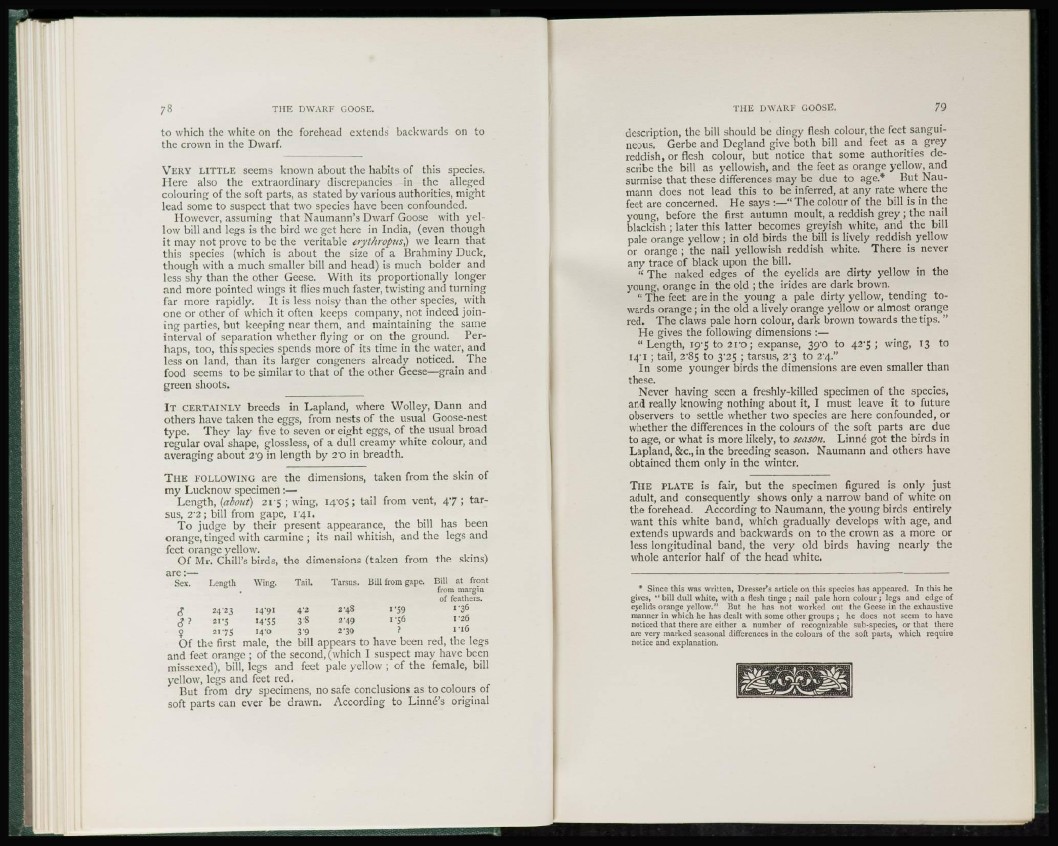
to which the white on the forehead extends backwards on to
the crown in the Dwarf.
VERY LITTLE seems known about the habits of this species.
Here also the extraordinary discrepancies in the alleged
colouring of the soft parts, as stated by various authorities, might
lead some to suspect that two species have been confounded.
However, assuming that Naumann's Dwarf Goose with yellow
bill and legs is the bird wc get here in India, (even though
it may not prove to be the veritable erytkropus) we learn that
this species (which is about the size of a Brahminy Duck,
though with a much smaller bill and head) is much bolder and
less shy than the other Geese. With its proportionally longer
and more pointed wings it flies much faster, twisting and turning
far more rapidly. It is less noisy than the other species, with
one or other of which it often keeps company, not indeed joining
parties, but keeping near them, and maintaining the same
interval of separation whether flying or on the ground. Perhaps,
too, this species spends more of its time in the water, and
less on land, than its larger congeners already noticed. The
food seems to be similar to that of the other Geese—grain and
green shoots.
IT CERTAINLY breeds in Lapland, where Wolley, Dann and
others have taken the eggs, from nests of the usual Goose-nest
type. They lay five to seven or eight eggs, of the usual broad
regular oval shape, glossless, of a dull creamy white colour, and
averaging about 2 9 in length by 2'0 in breadth.
THE FOLLOWING are the dimensions, taken from the skin of
my Lucknow specimen :—
Length, (about) 215 ; wing, 1405; tail from vent, 4 7 ; tarsus,
2'2 ; bill from gape, 141.
To judge by their present appearance, the bill has been
orange, tinged with carmine ; its nail whitish, and the legs and
feet orange yellow.
Of Mr. Chill's birds, the dimensions (taken from the skins)
Tarsus. Bill from gape. Bill at front
from margin
of feathers.
2-48 1-59 1-36
249 1-56 I-26
2'39 ? I*l6
_)pears to have been red, the legs
are :—
Sex. Length Wing. Tail.
cT 24'23 1491 4-2
6*? »455 3«
Î 21-75 14-0 3'9
Of th e first male, the bill
and feet orange ; of the second, (which I suspect may have been
missexed), bill, legs and feet pale yellow ; of the female, bill
yellow, legs and feet red.
Put from dry specimens, no safe conclusions as to colours of
soft parts can ever be drawn. According to Linne's original
description, the bill should be dingy flesh colour, the feet sanguineous.
Gerbe and Degland give both bill and feet as a grey
reddish, or flesh colour, but notice that some authorities describe
the bill as yellowish, and the feet as orange yellow, and
surmise that these differences may be due to age.* But Naumann
does not lead this to be inferred, at any rate where the
feet are concerned. He says :—" The colour of the bill is in the
young, before the first autumn moult, a reddish grey ; the nail
blackish ; later this latter becomes greyish white, and the bill
pale orange yellow ; in old birds the bill is lively reddish yellow
or orange ; the nail yellowish reddish white. There is never
any trace of black upon the bill.
" The naked edges of the eyelids arc dirty yellow in the
young, orange in the old ; the irides are dark brown.
" The feet are in the young a pale dirty yellow, tending towards
orange ; in the old a lively orange yellow or almost orange
red. The claws pale horn colour, dark brown towards the tips. "
He gives the following dimensions :—
"Length, i g - 5 t o 2 i - o ; expanse, 39-0 to 42-5; wing, 13 to
14-1 ; tail, 2-85 to 3'25 ; tarsus, 2'3 to 24."
In some younger birds the dimensions are even smaller than
these.
Never having seen a freshly-killed specimen of the species,
and really knowing nothing about it, I must leave it to future
observers to settle whether two species are here confounded, or
whether the differences in the colours of the soft parts are due
to age, or what is more likely, to season. Linné got the birds in
Lapland, Sc., in the breeding season. Naumann and others have
obtained them only in the winter.
THE PLATE is fair, but the specimen figured is only just
adult, and consequently shows only a narrow band of white on
the forehead. According to Naumann, the young birds entirely
want this white band, which gradually develops with age, and
extends upwards and backwards on to the crown as a more or
less longitudinal band, the very old birds having nearly the
whole anterior half of the head white.
* Since this was written, Dresser's article on this species has appeared. In this he
gives, " bill dull white, with a flesh tinge ; nail pale horn colour; legs and edge of
eyelids orange yellow." But he has not worked out the Geese in the exhaustive
manner in which he has dealt with some other groups ; he does not seem to have
noticed that there are either a number of recognizable sub-species, or that there
are very marked seasonal differences in the colours of the soft parts, which require
notice and explanation.